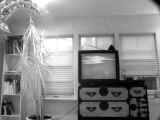
|
Color vs. Monochrome The MEGA-DCS comes in either color (STH-MDCS-C) or monochrome (STH-MDCS) versions. They both use the same underlying CMOS megapixel imaging array. The color version incorporates a Bayer pattern color filter on the pixels. Every set of four pixels has the color pattern:
A color image is reconstructed from this pattern by assigning R, G, and B values at every pixel of the color image. A luminance (monochrome) value can also be assigned by a suitable function of the four pixels. If the color image is the same size as the original Bayer image, then the colors and luminance must be interpolated. Because of the high resolution of the MEGA-DCS, non-interpolated color images at 640 x 480 are possible, and this is the standard mode for the STH-MDCS-C. By contrast, in a monochrome imager each element of the imager array records just the luminance at that pixel. There is no color information, but the luminance information is recorded at the full resolution of the imager. There are several important differences between the two types of stereo heads, in terms of image quality and stereo algorithms.
Although the monochrome imagers give better spatial resolution than the color imagers, the large number of pixels means that there is almost always adequate spatial resolution for an application. Hence we do not recommend monochrome over color, except where low light levels may be a factor. Check out the color and monochrome images for the MEGA-DCS here.
Infrared Characteristics The CMOS imagers in the MEGA-DCS are highly sensitive to near-infrared radiation (up to 950 nm). The following images show a scene with just IR light admitted to the imager, just visible light, and a combination of visible and IR.
Some objects reflect IR energy, e.g., vegetation and the lacquer in the Japanese tansu (the TV images were different over the three images, so ignore them). Most lenses are optimized for visible light, and longer IR wavelengths are not focused at the same distance as visible light. This creates blur when both IR and visible light are admitted to the imager, for both color and monochrome stereo heads. If you click on the first two images above to get larger images, and look at the books on the bookshelf, you can see much more detail in them. The Bayer color filter does not block near IR, so colors will be "washed out" if IR is admitted to the color imager. For these reasons, both the STH-MDCS and STH-MDCS-C incorporate a high-efficiency IR cut filter, which essentially eliminates all radiation over 700 nm. For near-IR work, the filter can be removed, and IR pass filters placed over the lenses to eliminate visible light, as in the third image above. Please contact Videre Design if you are interested in this option. The formula for computing range resolution is: dR = .0060 * R**2 / (16*90*L), where R is the range to the object, and L is the lens focal length. All dimensions should be in mm.
|


